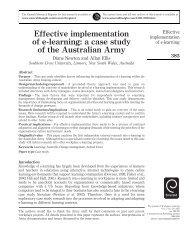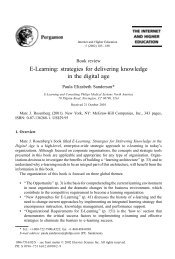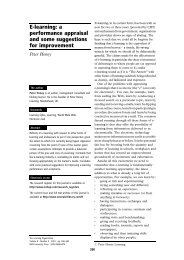Designing E-learning Interactions in the 21st Century: revisiting and ...
Designing E-learning Interactions in the 21st Century: revisiting and ...
Designing E-learning Interactions in the 21st Century: revisiting and ...
You also want an ePaper? Increase the reach of your titles
YUMPU automatically turns print PDFs into web optimized ePapers that Google loves.
Andrew Ravenscroft 145<br />
In short, a prescriptive model is usually required to provide a position to argue<br />
from, <strong>and</strong> subsequently `lock horns' <strong>in</strong> ways that stimulate reason<strong>in</strong>g that leads to<br />
<strong>the</strong> revision <strong>and</strong> ref<strong>in</strong>ement of knowledge.<br />
Learn<strong>in</strong>g through Argumentation <strong>and</strong> Constructive Conflict<br />
In contrast to Baker's (1989) system, a more radical approach to <strong>in</strong>structional<br />
epistemology <strong>and</strong> tutor<strong>in</strong>g strategy existed <strong>in</strong> <strong>the</strong> systems which actually opposed<br />
<strong>the</strong> learner's beliefs (Bloch & Farrell, 1988; Retalis, Pa<strong>in</strong> & Haggith, 1996),<br />
without necessarily evaluat<strong>in</strong>g <strong>the</strong>ir `validity', to support <strong>the</strong> <strong>learn<strong>in</strong>g</strong> of<br />
argumentation skills <strong>and</strong> competitive debate. The designers of <strong>the</strong>se systems<br />
were more <strong>in</strong>terested <strong>in</strong> support<strong>in</strong>g <strong>the</strong> acquisition of dialectic knowledge ra<strong>the</strong>r<br />
than doma<strong>in</strong> knowledge <strong>and</strong> <strong>the</strong>ir strategies supported this aim. DECIDER<br />
(Bloch & Farrell, 1988) followed a case-based problem solv<strong>in</strong>g paradigm for<br />
American foreign policy, construct<strong>in</strong>g counter arguments to <strong>the</strong> students'<br />
solutions, justified by alternative paradigm cases illustrat<strong>in</strong>g a different outcome.<br />
Unfortunately, this led to an epistemically narrow <strong>in</strong>teraction. Students<br />
concentrated on po<strong>in</strong>t<strong>in</strong>g out differences between <strong>the</strong>ir solution <strong>and</strong> <strong>the</strong> counter<br />
example without question<strong>in</strong>g <strong>the</strong> system's case or position at any higher level.<br />
Hence, it was questionable whe<strong>the</strong>r <strong>the</strong>y actually <strong>in</strong>ternalised <strong>the</strong> structure or<br />
process of argument.<br />
A more recent approach to teach<strong>in</strong>g argumentation skills <strong>and</strong> tutor<strong>in</strong>g <strong>in</strong><br />
controversial doma<strong>in</strong>s <strong>in</strong> general adopted a more sophisticated approach to<br />
argument structure. The OLIA (Retalis, Pa<strong>in</strong> & Haggith, 1996) system used a<br />
doma<strong>in</strong> <strong>in</strong>dependent meta-level argumentation framework (Haggith, 1995) to play<br />
both a Coach<strong>in</strong>g <strong>and</strong> Devil's Advocate Strategy with <strong>the</strong> learner. With<strong>in</strong> this<br />
framework, it was accepted that, although low-level representational<br />
expressiveness of propositional content was lost, this was compensated for by a<br />
rich, higher-level representation of structure <strong>in</strong> <strong>the</strong> form of <strong>in</strong>terpropositional<br />
connections. By apply<strong>in</strong>g <strong>the</strong> Devil's Advocate Strategy, <strong>the</strong> system aimed to<br />
explore <strong>in</strong>consistencies <strong>in</strong>stead of remov<strong>in</strong>g <strong>the</strong>m. Unfortunately, OLIA could<br />
support only limited <strong>in</strong>teractions, <strong>the</strong> `Devil' could only use one type of move <strong>and</strong><br />
students could not add <strong>the</strong>ir own propositions.<br />
In contrast, DIALAB (Pilk<strong>in</strong>gton, Hartley, H<strong>in</strong>tze & Moore, 1992) provided a<br />
range of dialogue moves represented <strong>in</strong> a dialogue game (MacKenzie, 1979;<br />
Walton, 1984) <strong>in</strong>terface to support <strong>learn<strong>in</strong>g</strong> skills of competitive debate <strong>and</strong><br />
provide a framework for manag<strong>in</strong>g a dialectical <strong>in</strong>teraction. However, <strong>the</strong><br />
DIALAB system had no doma<strong>in</strong> or strategic knowledge, so it could not argue<br />
with <strong>the</strong> learner, <strong>in</strong>stead it mediated an argument between two participants with<strong>in</strong><br />
<strong>the</strong> strictures of a particular dialogue game called <strong>the</strong> DC Dialogue Game<br />
(MacKenzie, 1979). This approach raises questions about <strong>the</strong> relationship<br />
between argument, reason<strong>in</strong>g <strong>and</strong> underst<strong>and</strong><strong>in</strong>g. It may be satisfactory for<br />
doma<strong>in</strong>s characterised by `uncerta<strong>in</strong> <strong>and</strong> <strong>in</strong>complete partially justified beliefs'<br />
(Baker, 1989), where <strong>the</strong>re is little consensus about `correct' or `<strong>in</strong>correct'<br />
knowledge. However, it is probably <strong>in</strong>adequate for doma<strong>in</strong>s where <strong>the</strong>re is some<br />
consensus about `correct' knowledge, <strong>and</strong> <strong>the</strong>refore <strong>the</strong> need for some<br />
specification or acquisition of knowledge by <strong>the</strong> system.<br />
However, later work has <strong>in</strong>tegrated doma<strong>in</strong> knowledge with<strong>in</strong> a dialogue game<br />
approach (Ravenscroft & Hartley, 1999; Ravenscroft & Pilk<strong>in</strong>gton, 2000). In<br />
ß Blackwell Publishers Ltd 2001
















